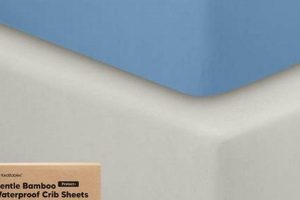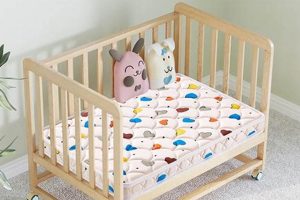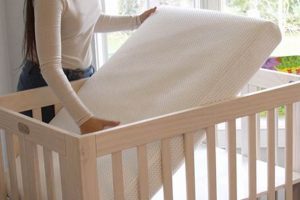Dimensions of infant sleeping surfaces are regulated to ensure a safe environment for babies. These specified sizes relate to the length, width, and thickness of the mattress designed to fit securely within a crib frame. For example, a standard-size sleeping pad intended for full-size cribs must adhere to specific dimensional guidelines to prevent entrapment hazards.
Adherence to regulated size specifications is crucial for preventing infant injury and promoting secure sleep. Historically, variations in sleeping pad dimensions led to increased risks of infants becoming trapped between the mattress and crib sides. Standardized sizing mitigates such hazards, contributing to enhanced safety and peace of mind for caregivers. The implementation of these standards has significantly reduced infant mortality and morbidity associated with unsafe sleep environments.
The following sections will detail the exact dimensional requirements for different crib types, methods for accurately measuring sleeping pads, and factors to consider when selecting a product that meets appropriate safety standards. Further examination will cover the impact of mattress construction and materials on overall safety and infant well-being.
Considerations for Accurate Crib Mattress Selection
Selecting the correct sleeping surface for an infant’s crib requires careful attention to established dimensional standards. Deviation from these standards can compromise safety and increase the risk of injury.
Tip 1: Verify Standard Dimensions: Ensure that any mattress intended for use in a full-size crib conforms to the legally mandated dimensions. A standard crib mattress should measure approximately 28 inches in width and 52 inches in length.
Tip 2: Measure Interior Crib Dimensions: Before purchasing a sleeping pad, accurately measure the interior dimensions of the crib. This step helps to confirm compatibility and prevent gaps between the mattress and crib frame.
Tip 3: Check for Firmness: A firm sleeping surface is essential for infant safety. The sleeping pad should be sufficiently firm to prevent indentations that could pose a suffocation hazard. Test firmness by pressing on the mattress; it should quickly regain its shape.
Tip 4: Assess Mattress Thickness: While width and length are critical, consider the thickness of the mattress in relation to the crib’s side height. The crib sides must extend a sufficient distance above the sleeping pad to prevent the child from climbing out.
Tip 5: Evaluate Material Safety: Choose sleeping pads constructed from non-toxic, breathable materials. Look for certifications indicating that the product has been tested for harmful chemicals and emissions.
Tip 6: Inspect for Proper Fit: Upon placement in the crib, examine the fit of the mattress. There should be no more than a two-finger gap between the mattress edge and the crib frame on any side. Excessively large gaps pose an entrapment risk.
Tip 7: Refer to Manufacturer Guidelines: Always consult the crib and sleeping pad manufacturer’s instructions and safety recommendations. Adhere to weight limits and usage guidelines to ensure safe operation.
Adhering to these recommendations regarding sleeping pad dimensions promotes a safe sleep environment, minimizing potential hazards and supporting infant well-being. Proper selection and installation of the sleeping surface are vital components of infant safety.
The following sections will delve deeper into specific safety standards and explore advanced considerations for crib mattress selection.
1. Standard Length
The dimensional specification of standard length is a cornerstone of sleeping pad safety regulations. Precise adherence to this specification minimizes potential hazards within the crib environment.
- Prevention of Entrapment Hazards
The standardized length is designed to prevent hazardous gaps between the sleeping pad and the crib frame. A length significantly shorter than the prescribed dimension allows space for an infant to become trapped, posing a risk of suffocation or injury. Conversely, a length exceeding the standard can lead to improper fit and instability within the crib structure.
- Consistency in Crib Manufacturing
The defined standard length allows for uniformity in crib manufacturing. Manufacturers adhere to this dimension, creating cribs designed to perfectly accommodate properly sized sleeping pads. This consistency minimizes discrepancies and ensures compatibility across different brands and models.
- Facilitation of Bedding and Accessory Compatibility
Bedding and accessories, such as fitted sheets, are designed around the standard sleeping pad dimensions. The specified length ensures that such items fit securely and function as intended. Incorrect dimensions can result in ill-fitting bedding, which can bunch up and create unsafe sleep conditions.
- Legal and Regulatory Compliance
Manufacturers are legally obligated to adhere to established sleeping pad length standards. Compliance with these regulations ensures that products meet minimum safety requirements and are suitable for infant use. Non-compliance can result in legal penalties and product recalls, highlighting the critical importance of adhering to the specified length dimension.
In summary, the standard length is a critical element of sleeping pad safety. Its precise specification and consistent application across the industry contribute significantly to reducing the risk of infant injury and promoting a safe sleep environment. Disregarding this dimension introduces potentially life-threatening hazards.
2. Standard Width
The dimensional specification of standard width is a critical component within the broader context of sleeping pad measurements for infant cribs. Its significance lies in its direct impact on infant safety and the overall functionality of the sleep environment. The standard width, typically around 28 inches, works in conjunction with standard length to create a secure fit within the crib frame. A deviation from this standard, either undersized or oversized, directly compromises the intended safety features. For instance, a sleeping pad with a width significantly less than 28 inches introduces gaps between the mattress and the crib sides. This scenario presents a potential entrapment hazard where an infant could become wedged, leading to suffocation or injury. Conversely, a width exceeding the standard could create a dangerously tight fit, potentially damaging the crib structure or compromising the mattress’s structural integrity.
The practical application of understanding the importance of standard width extends beyond mere adherence to regulations. It informs consumer choices, guiding purchasers to select products that genuinely contribute to a safe sleep environment. For example, parents and caregivers should actively verify that the chosen sleeping pad conforms to the accepted standard, rather than relying solely on manufacturer claims. Real-world examples of incidents involving non-compliant mattresses highlight the necessity of diligent measurement and verification. Furthermore, the precise width dimension plays a crucial role in ensuring proper ventilation within the crib. An appropriately sized sleeping pad allows for optimal airflow, mitigating the risk of overheating or carbon dioxide build-up around the infant’s face. Selecting a sleeping pad within the specification is essential for both safety and the infant’s thermal comfort.
In conclusion, the standard width specification is not merely an arbitrary measurement but an integral element of crib mattress safety. Adhering to this dimension is essential for preventing entrapment hazards, ensuring crib functionality, and promoting proper ventilation. Challenges in ensuring compliance include variable manufacturing standards and potential discrepancies between labeled and actual dimensions. Diligent verification and adherence to established guidelines are vital for mitigating risks and safeguarding infant well-being, underscoring the critical connection between standard width and overall sleeping pad safety.
3. Thickness Tolerances
The specifications governing the thickness of infant sleeping pads constitute a critical, albeit often overlooked, aspect of overall crib safety regulations. Thickness tolerances directly influence the effectiveness of crib side rail height and the prevention of infant falls. Deviations from established thickness standards can compromise the intended safety features of the crib system.
- Relationship to Side Rail Height
The height of crib side rails is predicated on a standardized sleeping pad thickness. If the mattress exceeds the allowable thickness tolerance, it effectively reduces the height of the side rail. This reduction creates an increased risk of the infant being able to climb out of the crib and sustain injuries from a fall. Conversely, a mattress significantly thinner than the standard increases the distance between the mattress surface and the top of the rail, potentially creating a gap where an infant could become wedged.
- Impact on Mattress Firmness and Support
Thickness tolerances are intrinsically linked to the firmness and support provided by the sleeping pad. A mattress that is excessively thin may lack the required firmness to support the infant safely, increasing the risk of suffocation or positional asphyxia. Conversely, an overly thick mattress, while potentially firm, may not conform correctly to the crib dimensions, leading to uneven support and potential hazards.
- Consistency in Manufacturing Standards
Established thickness tolerances ensure a degree of uniformity across different sleeping pad manufacturers. These standards provide a benchmark for acceptable deviations from the ideal thickness, promoting consistency in product safety and performance. Manufacturers must adhere to these tolerances to ensure their products meet regulatory requirements and minimize potential risks to infants.
- Influence on Product Testing and Certification
Thickness tolerances play a significant role in the testing and certification processes for infant sleeping pads. Products are routinely tested to ensure they fall within the specified thickness range. Failure to meet these tolerances can result in product rejection or the revocation of safety certifications, highlighting the importance of adherence to these standards.
The interrelation between thickness tolerances and other crib dimensions cannot be overstated. The safety and efficacy of the entire crib system depend on the accurate adherence to established standards for all dimensions, including thickness. Vigilance in ensuring compliance with these specifications is paramount in safeguarding infant well-being within the crib environment.
4. Corner Radius
The dimensional specification of corner radius is an integral, albeit subtle, aspect of crib mattress measurements. It directly influences the fit, safety, and overall functionality of the sleeping pad within the confines of a crib.
- Prevention of Gap Formation
The specified corner radius of a crib mattress serves to minimize or eliminate gaps between the mattress and the crib frame at the corners. A properly sized radius ensures a snug fit, preventing infants from becoming entrapped in these spaces. The absence of a standardized corner radius could lead to inconsistent fits, increasing the risk of injury.
- Compatibility with Crib Design
Crib manufacturers adhere to established corner radius standards in their designs. A mattress with a non-conforming corner radius may not sit flush against the crib frame, potentially causing instability or uneven support. This compatibility is crucial for maintaining the structural integrity of the crib system.
- Impact on Bedding Fit
Fitted sheets and mattress protectors are designed to accommodate the standard corner radius of crib mattresses. A mattress with an irregular corner radius may cause bedding to fit improperly, leading to bunching or loose fabric. These issues can create unsafe sleep conditions for infants.
- Regulatory Compliance and Safety Standards
Corner radius specifications are often included in safety regulations governing crib mattress manufacturing. Adherence to these standards ensures that products meet minimum safety requirements and reduce the risk of infant injury. Regulatory bodies may conduct testing to verify compliance with corner radius standards.
In conclusion, the corner radius specification is not merely a cosmetic detail but a critical element of crib mattress measurements. It directly impacts the fit, safety, and functionality of the sleeping pad within the crib environment. Disregarding this dimension can compromise the overall safety and well-being of infants.
5. Edge Straightness
Edge straightness, concerning crib mattress measurements, refers to the degree to which the sides of the mattress conform to a linear plane. Deviations from straightness introduce dimensional inaccuracies that can compromise the safety and efficacy of the crib environment. A mattress exhibiting significant edge waviness or bowing creates gaps between the mattress edge and the crib frame, potentially allowing for infant entrapment. The dimensional tolerances for edge straightness are therefore critical parameters in manufacturing and quality control processes.
The importance of edge straightness extends beyond the immediate risk of entrapment. Irregular edges can also contribute to uneven support across the mattress surface. This unevenness can affect infant posture and potentially hinder proper spinal development. Furthermore, inconsistencies in edge straightness complicate the fitting of standard-sized crib sheets, increasing the likelihood of loose bedding that can pose a suffocation hazard. Real-world examples of product recalls due to poorly manufactured mattresses, exhibiting compromised edge straightness, underscore the tangible consequences of neglecting this dimensional aspect. Such incidents highlight the need for rigorous quality assurance and adherence to established manufacturing standards. Practical applications of this understanding are evident in routine quality control checks performed by manufacturers, where edge straightness is meticulously measured using precision instruments to ensure compliance with safety regulations.
In summary, edge straightness is a non-negotiable element within the broader context of crib mattress measurements. Its impact on safety, support, and bedding fit necessitates strict adherence to established tolerances. While challenges exist in maintaining consistent edge straightness across mass production, the potential consequences of non-compliance necessitate continuous improvement in manufacturing processes and robust quality control measures. The accurate assessment and maintenance of edge straightness directly contribute to a safer and more functional sleep environment for infants.
6. Compression resistance
Compression resistance, in the context of crib mattress measurements, denotes the ability of the mattress to withstand applied force without excessive deformation. This property is paramount for ensuring infant safety and promoting healthy sleep posture. Appropriate compression resistance, within specified dimensional parameters, is a critical design and manufacturing consideration.
- Support and Spinal Alignment
Adequate compression resistance provides consistent support for the infant’s body, facilitating proper spinal alignment during sleep. Insufficient resistance allows for excessive sinking, potentially leading to discomfort and musculoskeletal strain. Real-world examples demonstrate that mattresses lacking appropriate compression resistance can contribute to developmental issues and discomfort in infants. The mattress’s ability to maintain its shape under an infant’s weight is essential for healthy development.
- Suffocation Prevention
A mattress with appropriate compression resistance minimizes the risk of suffocation. Excessive indentation creates pockets that can conform to the infant’s face, potentially obstructing airways. Regulations governing crib mattress design often specify minimum compression resistance values to mitigate this hazard. An overly soft mattress creates suffocation risk.
- Durability and Longevity
Compression resistance is directly related to the durability and longevity of the mattress. Mattresses with superior compression resistance are more likely to retain their shape and support properties over time, extending their usable lifespan. Inferior resistance leads to premature sagging and degradation, compromising safety and comfort. A mattress’s ability to retain its integrity over prolonged use is directly tied to compression resistance.
- Impact on Dimensional Stability
Compression resistance influences the dimensional stability of the mattress. Excessive compression can alter the mattress’s length, width, and thickness, potentially creating gaps between the mattress and the crib frame. These gaps pose an entrapment hazard. Standardized compression resistance ensures that the mattress maintains its specified dimensions under normal use conditions.
The facets of compression resistance, as they relate to crib mattress measurements, are inextricably linked to infant safety and well-being. Precise control over compression resistance during manufacturing, coupled with rigorous testing to ensure compliance with safety standards, is essential for creating a secure and supportive sleep environment for infants. Without proper standards, there’s risk to the baby.
7. Weight specifications
Weight specifications, when considered in conjunction with crib mattress dimensions, are crucial for ensuring the structural integrity and safety of the infant sleep environment. These specifications directly influence the load-bearing capacity of the mattress and the overall stability of the crib system, thereby affecting infant safety.
- Load Distribution and Support
Weight specifications dictate the maximum weight the mattress can support without compromising its structural integrity or leading to uneven load distribution. Exceeding these limits can result in sagging, deformation, and reduced support for the infant’s body. Proper weight distribution is essential for promoting healthy spinal alignment and preventing discomfort. For example, a mattress designed to support a maximum of 30 pounds may exhibit compromised support if subjected to significantly higher weight, leading to potential safety hazards.
- Crib Frame Compatibility
Weight specifications also factor into the compatibility between the mattress and the crib frame. The frame must be capable of supporting the combined weight of the mattress and the infant without risk of collapse or structural failure. This interplay between mattress weight specifications and crib frame capacity is paramount for ensuring the stability of the entire system. Manufacturers typically provide guidance on appropriate mattress and infant weight limits for specific crib models.
- Material Durability and Longevity
Weight specifications are directly related to the durability and longevity of the mattress materials. A mattress designed to withstand specific weight loads is less likely to undergo premature wear and tear, maintaining its structural integrity and support properties over time. Exceeding the specified weight limits can accelerate material degradation, compromising the safety and comfort of the sleeping surface. High-quality materials and construction techniques contribute to enhanced weight-bearing capacity and prolonged mattress lifespan.
- Regulatory Compliance and Safety Standards
Weight specifications are often incorporated into regulatory compliance and safety standards governing crib mattress manufacturing. These standards establish minimum weight-bearing requirements to ensure that mattresses meet acceptable safety levels. Compliance with these standards involves rigorous testing to verify that mattresses can withstand specified weight loads without deformation or structural failure. Regulatory agencies may conduct periodic audits to ensure adherence to these standards, safeguarding infant well-being.
In synthesis, the interplay between weight specifications and crib mattress dimensions is indispensable for ensuring a secure and supportive sleep environment for infants. Adherence to established weight limits, combined with appropriate crib frame compatibility and durable material selection, is critical for maintaining the integrity and safety of the crib system. Diligent consideration of weight specifications throughout the design, manufacturing, and consumer selection processes is paramount for protecting infant health and promoting optimal sleep conditions.
Frequently Asked Questions
This section addresses commonly asked questions regarding crib mattress measurements, providing clarity and guidance to ensure a safe sleep environment for infants.
Question 1: What are the standard dimensions for a full-size crib mattress?
The officially mandated dimensions for a standard full-size crib mattress are approximately 28 inches in width and 52 inches in length. Adherence to these measurements is essential for preventing entrapment hazards.
Question 2: How critical is it to precisely match the specified dimensions?
Precise adherence to the specified dimensions is paramount. Gaps exceeding two fingers’ width between the mattress and crib frame pose a significant safety risk and must be avoided.
Question 3: What role does mattress thickness play in crib safety?
Mattress thickness impacts the effective height of the crib side rails. A mattress that is too thick reduces the side rail height, increasing the risk of the infant climbing out. Consult crib manufacturer guidelines for optimal mattress thickness.
Question 4: How should one verify the dimensional accuracy of a crib mattress?
Use a measuring tape to confirm the length and width of the mattress. Ensure corners are square and edges are straight. Compare these measurements against the crib’s interior dimensions to assess the fit.
Question 5: What potential risks arise from using a mattress with incorrect dimensions?
Using a mattress with incorrect dimensions can lead to entrapment, suffocation, and falls. Gaps between the mattress and crib frame create potential hazards, while improper thickness compromises side rail safety.
Question 6: Are there specific regulatory standards governing crib mattress dimensions?
Yes, numerous regulatory standards govern crib mattress dimensions to ensure infant safety. Compliance with these standards is mandatory for manufacturers and is essential for protecting infants from harm.
Adhering to established dimensional standards is a critical component of infant sleep safety. Consistent vigilance and accurate measurement are vital for mitigating potential hazards.
The following section provides resources for further reading and external links to relevant safety organizations.
crib mattress measurements
This exploration of crib mattress measurements has underscored the paramount importance of dimensional accuracy in ensuring infant safety. Established standards for length, width, thickness, corner radius, edge straightness, compression resistance, and weight specifications are not arbitrary metrics; they are critical safeguards designed to prevent entrapment, suffocation, and falls. Adherence to these standards is non-negotiable, representing a fundamental responsibility for both manufacturers and caregivers.
Given the potential consequences of dimensional non-compliance, ongoing vigilance and a commitment to rigorous quality control are essential. Future efforts should focus on enhancing manufacturing precision, strengthening regulatory oversight, and empowering consumers with the knowledge necessary to make informed decisions. The safety and well-being of infants depend on a collective dedication to upholding the integrity of crib mattress measurement standards.




![Best Crib Mattress Bed Frame [Guide] for Babies Organic & Natural Mattress Buyer’s Guide: Non-Toxic Sleep Solutions Best Crib Mattress Bed Frame [Guide] for Babies | Organic & Natural Mattress Buyer’s Guide: Non-Toxic Sleep Solutions](https://mattressworldpa.com/wp-content/uploads/2025/07/th-1293-300x200.jpg)
![Best Crib Mattress: Newton vs Naturepedic [2024] Organic & Natural Mattress Buyer’s Guide: Non-Toxic Sleep Solutions Best Crib Mattress: Newton vs Naturepedic [2024] | Organic & Natural Mattress Buyer’s Guide: Non-Toxic Sleep Solutions](https://mattressworldpa.com/wp-content/uploads/2025/07/th-1292-300x200.jpg)

